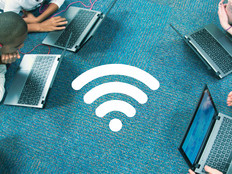The district — which had installed wireless access points in classrooms and other instructional areas about five years ago — worked with Cambium Networks to add its Xirrus XH2-240 high-performance exterior access points and install 10-gigabit HPE switches in school network closets. This enables students without home access to log on outside of the district’s 25 schools and two auxiliary buildings.
Because outside access points require only a data uplink to the internet and power, they can be a fairly quick way to expand network coverage, Miller says.
“It’s relatively easy to install the AP, poke a line into the building and connect to the building’s network,” he says. “You’re essentially taking the inside network and blasting it outside into the parking lot.”
Students pulled up and parked in front of schools during the hours they had online instruction scheduled.
“During the pandemic, it wasn’t unusual to see our parking lots full,” Honeycutt says. “At any given time, we were probably looking at anywhere between 50 to 75 connections. It might be 75 people from 8 a.m to 10 a.m., and then another 75 from 12 p.m. to 2 p.m.”
RELATED: Schools work to close the connectivity gap with expanded, optimized networks.
Until staff could safely come back into the building, many teachers also used the outdoor access, Honeycutt says.
“Between 5 and 8 percent of our teachers — maybe even 10 percent — had either weak access or no access,” she notes. “So many of them took advantage of that outside piece, as well.”
Reconfigurations Help Schools Prepare for Other Digital Upgrades
To implement outdoor and other connectivity solutions, Miller says, K–12 schools may have to update their infrastructure; for instance, ensuring firewalls have the appropriate capacity. Some districts can tap into federal funding to pay for the work.
As of October 2020, at least 39 states had promised to put federal Coronavirus Aid, Relief and Economic Security (CARES) Act funds toward addressing the K–12 digital divide, according to a National Conference of State Legislatures analysis.
“There is a definite awareness at the federal level about the digital divide and the homework gap,” Miller says. “There are programs they’ve put together to help inject funds into infrastructure to solve these problems. There are millions of dollars available, and many schools are taking advantage of that.”
States have also taken initiatives to help schools make online access more equitable. North Carolina, for instance, announced in July that it was forming an Office of Digital Equity and Literacy to help execute Gov. Roy Cooper’s plan to use more than $1 billion in American Rescue Plan funding to reduce the state’s digital divide.
Schools’ efforts to facilitate online access over the past year and a half may prove helpful in the future.











